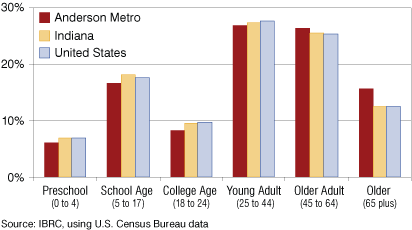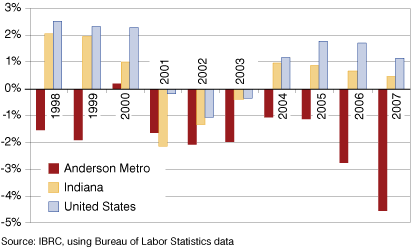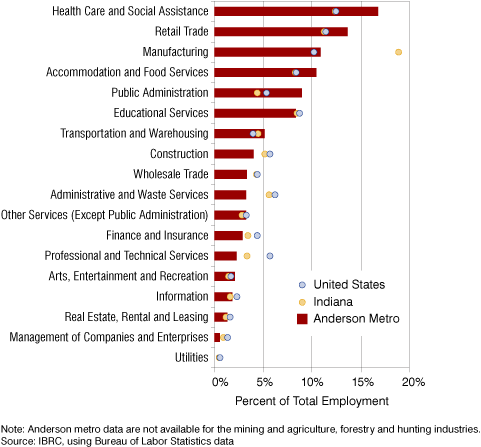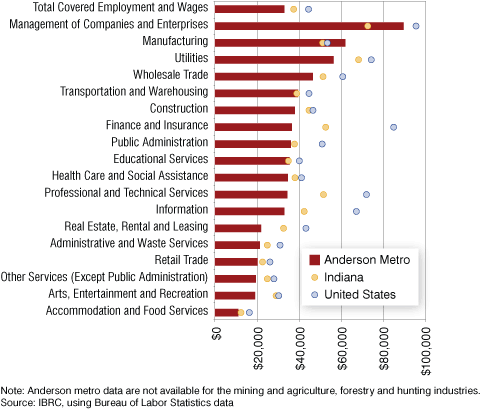The Anderson Metro Story: Told by STATS Indiana
This is the 10th in a series of articles on Indiana's metropolitan statistical areas (metros). All the data used in this article can be found using the USA Counties and Metros Side-by-Side feature on STATS Indiana (www.stats.indiana.edu) unless otherwise noted.
The Area
The population in the Anderson metro has dropped by about 2,000 people since the year 2000, though the area has seen slight growth since 2005.1 However, migration data for 2006 to 2007 indicate that domestic out-migration remains a concern for the area.
The median age (39.4 years) for the Anderson metro is about three years older than the state or nation. If we look at population by age data we find that the metro has a higher percentage of its population in the 45-and-older categories (see Figure 1).
Figure 1: Population by Age for the Anderson Metro, Indiana and the United States, 2007

Jobs and Wages
Annual employment in the Anderson metro has declined every year since 1997 except for the year 2000, where it experienced a 78-person increase. Meanwhile, the state and nation both experienced negative growth from 2001 to 2003 but managed to see gains during all other years (see Figure 2).
Figure 2: Percent Change in Employment from Previous Year, 1998 to 2007

The area's largest employer was the health care and social services industry, accounting for 16.8 percent of total employment in 2007—the most recent available annual data. Retail trade followed with 13.6 percent of employment and manufacturing came in third with 10.9 percent of employment (see Figure 3). For the state, the order of the top three industries was rearranged: manufacturing was first with 18.9 percent of employment, health care and social assistance provided 12.4 percent of jobs, and retail trade made up 11.3 percent.
Figure 3: Employment by Industry as a Percent of Total Employment in the Anderson Metro, Indiana and the United States, 2007

Similar to Anderson's population, the metro's average wages per job (when adjusted to their equivalent 2007 dollars) have decreased over the 10-year span, coming in lower than both the state and national average wages. In fact, Anderson metro wages paid less than 75 percent of U.S. wages, even lower than Indiana's 84.4 percent of U.S. wages.
Only one industry paid higher wages in the metro than in the state or nation: manufacturing. The average wage for manufacturing workers in 2007 was $61,698 in the Anderson metro. The United States overall paid an average $53,544 to manufacturing workers, and Indiana paid even less at $51,144 (see Figure 4).
Figure 4: Average Annual Wages by Industry in the Anderson Metro, Indiana and the United States, 2007

Not including agriculture and mining, for which no metro data were available, finance and insurance had the biggest gap between Anderson's wages and the nation's average. Finance and insurance workers in the Anderson metro averaged $36,407 per year compared to $84,858 nationwide. That said, the finance and insurance industry only makes up 2.8 percent of employment in the metro and 4.4 percent in the United States.
Conclusion
The Anderson metro is experiencing significant change in its population, employment and wages. However, the community's economic development, arts and culture, and environmental efforts' impact should soon reveal themselves in the data. The Anderson metro has, according to varied news reports, instituted many new initiatives to seize the opportunity to envision a different and likely a stronger economy.
Note
- Rachel Justis, "Population Change Among Indiana's Metros," InContext, May 2008, www.incontext.indiana.edu/2008/may/5.asp.
Molly Manns, Associate Editor
Indiana Business Research Center, Kelley School of Business, Indiana University
